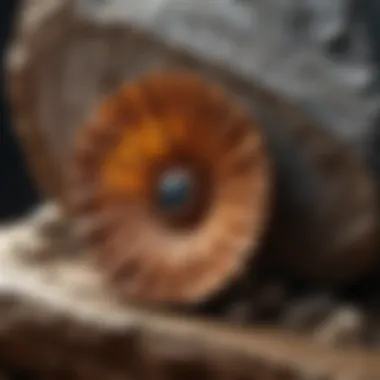Unveiling the Intricacies of Trim Saws in Rock and Fossil Collecting


Rock and Fossil Intidentification
Rock and fossil identification play a crucial role in the field of rock and fossil collecting as they form the foundation for understanding geological specimens. Various types of rocks and fossils exist, each with unique characteristics that aid in their identification. When examining rocks, key attributes to consider include composition, color, texture, and mineral content. Fossils, on the other hand, may reveal intricate details about prehistoric life based on their structure, imprints, or remnants.
To assist in the identification process, collectors utilize a range of tools such as magnifying glasses, UV lights, chisels, and field guides. These instruments help in magnifying features, examining details, and cross-referencing findings with existing knowledge or databases. By honing their observational skills and knowledge of geology, collectors can accurately identify various rocks and fossils, enriching their understanding of earth's history and composition.
Collecting Tips and Tcweqniques
When venturing into the realm of rock and fossil collecting, embracing best practices is essential to ensure a fruitful and ethical experience. Collectors are encouraged to respect natural environments, adhere to local regulations, and seek permission before collecting specimens. By following ethical guidelines, collectors contribute to the preservation of geological treasures for future generations and maintain the ecological balance of delicate ecosystems.
The journey to locate prime collecting sites involves research, exploration, and a keen eye for detail. Geology maps, topographic surveys, and online resources can aid in pinpointing geological hotspots where rocks and fossils are abundant. Once a promising location is identified, collectors must employ safe extraction techniques to avoid damaging specimens and ensure their own safety. Methods such as using geological hammers, chisels, and protective gear help in carefully unearthing specimens without causing harm to the environment or oneself.
Preservation and Dipslay
Preserving rocks and fossils is a meticulous process that requires attention to detail and adherence to conservation practices. By employing techniques such as cleaning, stabilization, and protective coatings, collectors can safeguard specimens from deterioration or external damage. Proper storage methods, including airtight containers, archival paper, and climate-controlled environments, aid in maintaining the integrity of specimens over time.
In addition to preservation, creative display ideas enhance the aesthetic appeal of rock and fossil collections. Thoughtful arrangements, custom stands, and lighting accents can transform a collection into a visually captivating exhibit. By showcasing specimens in a compelling manner, collectors not only highlight the beauty of rocks and fossils but also share their passion for geology with others.
Geological Insights
Delving deeper into the world of geology opens doors to profound insights into Earth's history, geological formations, and processes that have shaped the planet over millennia. By studying geological formations such as sedimentary layers, volcanic rocks, and metamorphic structures, collectors gain a deeper understanding of the forces that have sculpted the planet's surface.
The historical significance of rocks and fossils extends beyond their geological value, offering clues about past climates, ecosystems, and even evolutionary pathways of life on Earth. Notable discoveries in the field of paleontology have contributed to our understanding of ancient organisms, mass extinctions, and the evolution of species. Through these discoveries, collectors and researchers alike unravel the mysteries of the Earth's past, adding pieces to the puzzle of our planet's rich and diverse history.
- Water Supply System The water supply system is integral to trim saw operation, facilitating cooling and lubrication during cutting. Proper water supply helps dissipate heat generated during cutting, preventing overheating and blade damage. The key characteristic of water supply systems lies in their ability to maintain cutting precision through effective cooling and debris removal. While managing the water supply system may necessitate periodic maintenance and monitoring, its advantages in enhancing cutting efficiency and prolonging blade life underscore its importance in trim saw setups.
Choosing the Right Trim Saw
When considering the acquisition of a trim saw for rock and fossil collecting purposes, the decision-making process is paramount to ensure optimal performance and efficiency. Selecting the right trim saw plays a pivotal role in the meticulous extraction and preparation of geological specimens. Several key elements need to be carefully evaluated to make an informed choice about the trim saw that best suits the specific requirements of the task at hand.
Factors to Consider
Size and Weight


Size and weight are integral factors to contemplate when selecting a trim saw. The dimensions of the trim saw dictate its portability and usability in varying geological settings. A balance between a compact size for maneuverability and sufficient weight for stability is crucial. Opting for a trim saw that is lightweight yet sturdy can significantly enhance the overall handling experience and precision during cutting operations. Although a larger size may provide more substantial cutting capacity, it could potentially limit mobility and versatility in rugged terrains.
Blade Type and Size
The blade type and size are critical considerations in choosing a trim saw that aligns with the specific cutting requirements. Different blade types offer varying capabilities in terms of precision cutting, durability, and compatibility with different rock or fossil compositions. Selecting the appropriate blade size ensures efficient cutting processes while minimizing material wastage. It is essential to match the blade size with the specimen size to achieve optimal results and meticulous specimen preparation.
Motor Power
Motor power is a key determinant of the cutting efficiency and speed of a trim saw. The motor's capacity to deliver high torque and consistent rotation directly affects the cutting performance, especially when processing dense or hard geological materials. Choosing a trim saw with adequate motor power ensures smooth cutting operations with minimal strain on the equipment. However, excessively high motor power may lead to unnecessary energy consumption and could be overpowering for smaller cutting tasks.
Popular Brands in the Market
Celestron
Celestron stands out as a reputable brand known for its precision-engineered trim saws specifically designed for rock and fossil cutting applications. The key characteristic of Celestron trim saws is their advanced blade technology, ensuring swift and precise cuts across a wide range of geological specimens. The unique feature of Celestron products lies in their user-friendly interface, making them ideal for both amateur and seasoned collectors. While Celestron trim saws excel in precision cutting, some users may find them relatively pricier compared to other brands in the market.
Diamond Pacific
Diamond Pacific is synonymous with high-quality lapidary equipment, including trim saws renowned for their durability and performance. The key characteristic of Diamond Pacific trim saws is their robust construction, capable of withstanding prolonged usage in demanding environments. The unique feature of Diamond Pacific products is their versatility, allowing users to tackle a diverse range of cutting tasks with ease. However, some users may encounter challenges with the weight of Diamond Pacific trim saws, particularly during transportation to field sites.
Kingsley North
Kingsley North is a trusted name in the lapidary industry, offering a range of reliable trim saws for rock and fossil enthusiasts. The key characteristic of Kingsley North trim saws is their precision blade alignment, ensuring consistent and accurate cutting results. The unique feature of Kingsley North products is their emphasis on user safety, incorporating enhanced safety features for secure operation. While Kingsley North trim saws provide efficient cutting performance, some users may find the maintenance of certain components relatively time-consuming.
These detailed insights into the factors to consider when choosing the right trim saw and the popular brands in the market aim to equip rock and fossil collectors with essential knowledge for informed decision-making and enhanced cutting experiences.
Operating a Trim Saw Safely
In the realm of rock and fossil collecting, operating a trim saw safely is of paramount importance. The meticulous process of specimen extraction and preparation necessitates precision and care to avoid accidents and damage to valuable specimens. Ensuring safety not only protects the operator but also safeguards the integrity of the specimens being worked on. Safe operation begins with adherence to comprehensive safety guidelines and practices that mitigate risks and promote efficiency in the workflow.
Safety Guidelines
Wearing Protective Gear


Wearing protective gear is a fundamental aspect of safe operation when using a trim saw. This includes safety goggles to protect the eyes from debris, gloves for hand protection, and ear protection to minimize noise exposure. The key characteristic of wearing protective gear is that it acts as a barrier against potential hazards, shielding the operator from harm. Its substantial benefit lies in reducing the risk of injuries and ensuring a secure working environment conducive to focused and uninterrupted work. Embracing the use of protective gear underscores a commitment to both personal safety and the proper handling of specimens in the rock and fossil collecting process.
Proper Ventilation
Proper ventilation is indispensable in the context of operating a trim saw safely. Adequate airflow in the workspace helps dissipate harmful fumes and dust generated during cutting activities. The key characteristic of proper ventilation is its capacity to maintain air quality at optimal levels, reducing the inhalation of harmful particles. A well-ventilated environment is a popular choice for rock and fossil collectors as it promotes respiratory health and ensures a clean and safe workspace. Implementing proper ventilation enhances operator comfort and productivity while mitigating health risks associated with prolonged exposure to airborne particles.
Regular Maintenance
Regular maintenance is a critical aspect of ensuring the safe operation of a trim saw. This practice involves thorough inspection and upkeep of the saw's components, including the blade, motor, and water supply system. The key characteristic of regular maintenance is its capacity to identify and address potential issues before they escalate, ensuring the saw functions optimally. A beneficial choice for this article, regular maintenance prevents unexpected breakdowns and promotes the longevity of the equipment. While the advantages of regular maintenance include improved performance and reliability, neglecting this aspect could lead to operational inefficiencies and compromised safety standards.
Step-by-Step Usage Instructions
Setting Up the Trim Saw
Setting up the trim saw is a crucial step that sets the foundation for safe and efficient operation. This process involves securing the saw in a stable position, ensuring proper alignment of the blade, and adjusting cutting settings as per the specimen's requirements. The key characteristic of setting up the trim saw is its role in establishing the conditions for precise cutting and preventing equipment vibrations. A beneficial choice for this article, setting up the trim saw accurately ensures consistent results and minimizes the risk of accidents. The unique feature of setting up the trim saw lies in its ability to customize cutting parameters based on the properties of the specimen, catering to specific cutting needs and ensuring optimal outcomes.
Adjusting Cutting Speed
Adjusting cutting speed is a critical aspect of operating a trim saw efficiently and safely. This adjustment allows for control over the cutting process, enabling operators to modulate speed based on the hardness of the material being worked on. The key characteristic of adjusting cutting speed is its impact on cutting precision and blade longevity. A popular choice for this article, adjusting cutting speed according to the specimen's characteristics ensures accurate cuts and reduces the risk of blade wear. The unique feature of adjusting cutting speed is its responsiveness to operator input, offering flexibility and customization in the cutting process to achieve desired results.
Handling Specimens Correctly
Handling specimens correctly is essential to ensure their integrity and the safety of the operator. This involves carefully positioning the specimen on the cutting platform, securing it in place, and guiding its movement during the cutting process. The key characteristic of handling specimens correctly is its role in preventing accidents and maintaining specimen quality. A beneficial choice for this article, proper specimen handling minimizes the risk of damage and ensures precise cuts. The unique feature of handling specimens correctly lies in the operator's ability to manipulate the specimen with precision and care, reflecting a commitment to meticulous specimen preparation and safety standards.
Maintenance and Care Tips
When we discuss trim saws in the realm of rock and fossil collecting, it becomes imperative to delve into the crucial aspect of maintenance and care. In this dynamic field where precision is paramount, ensuring the longevity and optimal performance of your trim saw is non-negotiable. By following best practices in maintenance and care, collectors can enhance the efficiency and accuracy of their specimen preparation processes. Embracing a meticulous approach to maintenance not only prolongs the lifespan of your equipment but also contributes significantly to the quality of the specimens obtained.
Cleaning and Lubrication
Removing Debris
In the meticulous world of rock and fossil collection, the process of removing debris plays a pivotal role in maintaining the functionality of trim saws. Effective removal of debris ensures that the cutting mechanisms operate smoothly and with precision. By eliminating debris buildup, collectors can minimize the risk of inaccuracies in cuts and damage to the specimens. Keeping the saw free from debris is a popular choice among experienced collectors due to its direct impact on the quality of the final specimens. The unique feature of removing debris lies in its ability to optimize cutting precision by preventing the obstruction of the blade path and enhancing overall cutting efficiency.


Applying Lubricant
Application of lubricant is another critical aspect of trim saw maintenance that directly influences the performance and longevity of the equipment. Lubricants help reduce friction during cutting, leading to smoother operation and preventing wear and tear on essential components. The key characteristic of applying lubricant is its ability to ensure the seamless functioning of moving parts within the saw, thereby extending its operational life. This practice is highly beneficial for collectors as it not only improves the cutting experience but also protects the saw from premature deterioration. While applying lubricant enhances cutting efficiency, it is essential to consider the type and quantity of lubricant to avoid potential disadvantages such as oversaturation.
Preventing Corrosion
In the context of trim saw maintenance, preventing corrosion is a fundamental consideration to safeguard the integrity of the equipment. Corrosion can compromise the structural stability of the saw, leading to reduced cutting precision and potentially damaging the specimens. By implementing corrosion prevention measures, collectors can prolong the lifespan of their trim saws and maintain optimal cutting performance. The key characteristic of preventing corrosion lies in its ability to preserve the structural integrity of the saw, ensuring long-term functionality. This practice offers notable advantages such as extended equipment lifespan and enhanced cutting accuracy, underscoring its significance in the context of rock and fossil collection.
Storage Practices
Dry and Cool Environment
Maintaining a dry and cool environment for storing trim saws is paramount in ensuring their longevity and performance. Exposure to excessive moisture or heat can adversely impact the structural integrity of the saw and contribute to corrosion or mechanical issues. By storing the saw in an environment with controlled humidity and temperature, collectors can mitigate the risk of damage and preserve the functionality of the equipment. The key characteristic of a dry and cool environment is its ability to protect the saw from environmental factors that could compromise its performance, making it a preferred choice for preserving trim saws effectively.
Covering Exposed Parts
Protecting exposed parts of the saw is essential for preventing dust accumulation and minimizing the risk of damage. Covering vulnerable components such as the blade and motor prevents debris from settling and potentially causing operational issues. By safeguarding exposed parts when the saw is not in use, collectors can prolong its lifespan and minimize the need for extensive cleaning or repairs. The unique feature of covering exposed parts lies in its proactive approach to equipment maintenance, offering advantages such as enhanced durability and reduced maintenance requirements.
Regular Inspection
Conducting regular inspections of the trim saw is a proactive measure that can identify potential issues early on and prevent major malfunctions. Inspecting the saw for signs of wear, loose components, or damage enables collectors to address these issues promptly and maintain the saw's optimal performance. The key characteristic of regular inspection is its role in ensuring the continued reliability and efficiency of the equipment, allowing collectors to address minor issues before they escalate. This practice offers benefits such as increased operational lifespan and consistent cutting accuracy, making it an indispensable aspect of trim saw maintenance in the context of rock and fossil collecting.
Conclusion
In delving deep into the intricacies of trim saws in the realm of rock and fossil collecting, it becomes evident that the topic of Conclusion holds immense significance. Through this comprehensive guide, rock and fossil collectors can grasp the pivotal role that trim saws play in the meticulous process of specimen extraction and preparation. Understanding the importance of precision in geological specimen work is paramount for enthusiasts seeking to enhance their collection experiences and optimize efficiency in their workflow. By embracing the precision that trim saws offer, collectors equip themselves with a tool that not only refines their craft but also elevates the quality of their specimens to unparalleled levels.
Embracing the Precision of Trim Saws
Efficiency in Specimen Preparation
Efficiency in specimen preparation stands as a cornerstone in the functionality of trim saws. This particular aspect accentuates the ability of trim saws to streamline the cutting process, ensuring minimal material loss while maximizing precision. The key characteristic of efficiency in specimen preparation lies in its capacity to expedite the trimming of rocks and fossils without compromising accuracy. This efficiency is a favored choice in the context of this article due to its direct contribution to the overall goal of enhancing the quality and speed of geological specimen preparation. The unique feature of efficiency in specimen preparation lies in its ability to significantly reduce operational time without sacrificing the precision required in collecting high-quality geological specimens.
Enhanced Collection Experience
Enhancing the collection experience is a vital component influenced by the utilization of trim saws. This particular aspect enriches the overall journey of rock and fossil collectors by elevating the quality of their specimens and fostering a sense of accomplishment in their work. The key characteristic of an enhanced collection experience is its capacity to transform how collectors engage with their geological findings, offering a deeper sense of fulfillment and satisfaction. This enhancement is considered a beneficial choice for this article as it underscores the holistic impact that proper specimen preparation can have on enriching the collector's experience. The unique feature of an enhanced collection experience is its ability to create a strong connection between collectors and their geological treasures, heightening the appreciation for the natural world's wonders.
Essential Tool for Serious Collectors
Viewed as an indispensable instrument, trim saws serve as an essential tool for serious collectors invested in the meticulous art of rock and fossil collection. This specific aspect highlights the critical role that trim saws play in ensuring the precision and quality of geological specimens. The key characteristic of a trim saw as an essential tool for serious collectors is its reliability and consistency in delivering precise cuts, thereby solidifying its status as a must-have device. This tool is a popular choice in this article due to its fundamental contribution to the success of serious collectors in obtaining, trimming, and presenting their geological findings. The unique feature of a trim saw as an essential tool for serious collectors is its ability to meet the exacting standards of dedicated enthusiasts, enhancing not only their workflow but also the overall caliber of their collections.







